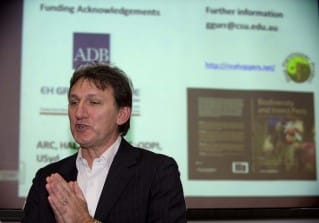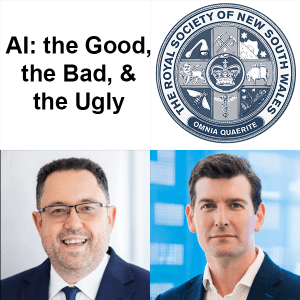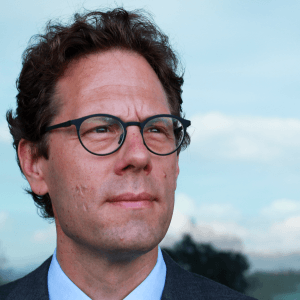
“Biodiversity and the future of agriculture” – Professor Geoff Gurr
After a hiatus of 20 years, the Poggendorf Lecture was delivered in conjunction with Charles Sturt University, Orange, on Tuesday, 13 August 2013. The lecture was delivered by Professor Geoff Gurr, a biologist and entomologist and Professor of Applied Ecology at Charles Sturt University, where he specialises in the utilisation of natural solutions to control agricultural pests to partially or completely replace synthetic pesticides.
The population of the world is increasing by 170,000 souls per day. Currently, 40% of land is used for some agricultural purpose and the demand for agricultural products is expected to increase not only as a consequence of population growth but by the increasing living standards of people in the developing world. For example, the growth in meat demand is very strong and it takes 10 kg of grain to produce 1 kg of animal protein. This leads to the conclusion that food production needs to double by 2050. The so-called “green revolution” of the last few decades has enabled the increase in food production to largely match population growth, largely through the application of nitrogen, phosphorus, some trace elements, water and the wide-scale use of pesticides. But was this revolution truly “green”? Human inputs are largely non-renewable but, importantly, do not actually address the root cause of the problem – pest outbreaks are not due to a lack of pesticide, they are due to other imbalances in the environment. So the world is faced with a “wicked problem” of seeking food security, having finite renewable resources, a declining availability of agricultural land, changing climate and a moral obligation to preserve biodiversity (human activity, including agriculture, causes biodiversity loss at a rate about 10,000 times greater than the background rate).
Sustainable agricultural practices that are emerging can be considered in three areas: genetic (utilising the natural defence mechanisms identified in certain species and transferring these to other species); species (utilising the natural enemies of pests in order to control population); and ecosystems (developing landscapes that have high biodiversity that tends to equilibrate around sustainable species populations).
The thrust of Professor Gurr’s work is that by integrating diverse approaches, including biological, cultural and chemical controls, hazards to humans and the environment can be minimised and, in many cases, productivity of agricultural systems can be improved. The principle underlying this is the acknowledgement that agricultural landscapes benefit from biodiversity and that this has significant benefit in terms of ecosystem services such as pollination of crops, reducing erosion, reducing contamination of water courses with excess nutrients and biological control of crop pests.
Generally, the greater the biological diversity, the fewer the pests. This is because the natural activity of predators, parasites and pathogens maintain potential pests’ population densities at a lower level than would occur in their absence. In the case of monocultures, this balance is often upset, enabling the density of pests to get to plague proportions. The widely accepted agricultural response to this is to use synthetic pesticides which often exacerbate the problem by further reducing biological diversity. In turn, the levels of artificial agents required to control pests increases with the consequent damage to the environment.
Professor Gurr described an example in China where rice production was being severely affected by a particular species of plant hopper. This species had evolved resistance to insecticides and was substantially reducing rice yield. Professor Gurr’s group investigated the use of bund walls used to retain water in rice fields to plant vegetation selected because it was a host to predators for this species as plant hopper. They also introduced another species of plant hopper that did not affect rice yield and attacked the pest species. In addition, they planted species of flowers that attracted parasitic wasps that attacked the pest species. The result was a substantial reduction in the pest species, leading to significantly increased rice field, with secondary benefits, for example increase in the frog population.
There is a common misconception that this type of biological control can have negative impact on yield but a meta-analysis of 286 projects demonstrated an average 80% increase in yield. The “green” approach to pest management potentially could double food production in 10 years: the challenge is to identify the value of ecosystem services and how to utilise them.
Historically, agricultural science has focused on agricultural production and environmental science has focused on protecting the environment – these have coexisted almost as separate disciplines. If food security is to be accomplished in the next few decades, there needs to be an integration of agricultural and environmental protection practices. China has been very active in this. 24% of agricultural land in China has been allocated some form of conservation status. Similarly in Europe, there is a trend towards farmers being encouraged to consider themselves as stewards of the land, rather than owners.
Regrettably, Australia is not leading the way in this area. Nonetheless, there are examples of this type of approach such as “alley farming” that provide shelter for natural species and encourages biological diversity thereby reducing significantly the requirement for synthetic pesticides.
Professor Gurr concluded by observing that the world cannot double food production with the current agricultural practices – they are simply unsustainable. If we learn to value ecosystem services, in particular recognising the importance of biodiversity, doubling food production, a requirement to feed the projected world population is both achievable and potentially beneficial to the global ecosystem.








